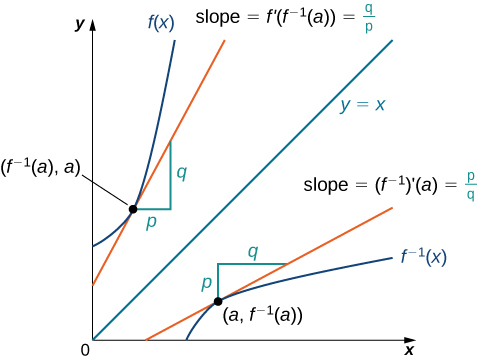Learning Outcomes
- Calculate the derivative of an inverse function
We begin by considering a function and its inverse. If [latex]f(x)[/latex] is both invertible and differentiable, it seems reasonable that the inverse of [latex]f(x)[/latex] is also differentiable. Figure 1 shows the relationship between a function [latex]f(x)[/latex] and its inverse [latex]f^{-1}(x)[/latex]. Look at the point [latex](a,f^{-1}(a))[/latex] on the graph of [latex]f^{-1}(x)[/latex] having a tangent line with a slope of [latex](f^{-1})^{\prime}(a)=\frac{p}{q}[/latex]. This point corresponds to a point [latex](f^{-1}(a),a)[/latex] on the graph of [latex]f(x)[/latex] having a tangent line with a slope of [latex]f^{\prime}(f^{-1}(a))=\frac{q}{p}[/latex]. Thus, if [latex]f^{-1}(x)[/latex] is differentiable at [latex]a[/latex], then it must be the case that

Figure 1. The tangent lines of a function and its inverse are related; so, too, are the derivatives of these functions.
We may also derive the formula for the derivative of the inverse by first recalling that [latex]x=f(f^{-1}(x))[/latex]. Then by differentiating both sides of this equation (using the chain rule on the right), we obtain
Solving for [latex](f^{-1})^{\prime}(x)[/latex], we obtain
We summarize this result in the following theorem.
Inverse Function Theorem
Let [latex]f(x)[/latex] be a function that is both invertible and differentiable. Let [latex]y=f^{-1}(x)[/latex] be the inverse of [latex]f(x)[/latex]. For all [latex]x[/latex] satisfying [latex]f^{\prime}(f^{-1}(x))\ne 0[/latex],
Alternatively, if [latex]y=g(x)[/latex] is the inverse of [latex]f(x)[/latex], then
Example: Applying the Inverse Function Theorem, 1
Use the Inverse Function Theorem to find the derivative of [latex]g(x)=\dfrac{x+2}{x}[/latex]. Compare the resulting derivative to that obtained by differentiating the function directly.
Watch the following video to see the worked solution to Example: Applying the Inverse Function Theorem, 1.
Try It
Use the inverse function theorem to find the derivative of [latex]g(x)=\dfrac{1}{x+2}.[/latex] Compare the result obtained by differentiating [latex]g(x)[/latex] directly.
Hint
Use the preceding example as a guide.
Example: Applying the Inverse Function Theorem, 2
Use the inverse function theorem to find the derivative of [latex]g(x)=\sqrt[3]{x}[/latex].
Try It
Find the derivative of [latex]g(x)=\sqrt[5]{x}[/latex] by applying the inverse function theorem.
From the previous example, we see that we can use the inverse function theorem to extend the power rule to exponents of the form [latex]\frac{1}{n}[/latex], where [latex]n[/latex] is a positive integer. This extension will ultimately allow us to differentiate [latex]x^q[/latex], where [latex]q[/latex] is any rational number.
Extending the Power Rule to Rational Exponents
The power rule may be extended to rational exponents. That is, if [latex]n[/latex] is a positive integer, then
Also, if [latex]n[/latex] is a positive integer and [latex]m[/latex] is an arbitrary integer, then
Proof
The function [latex]g(x)=x^{1/n}[/latex] is the inverse of the function [latex]f(x)=x^n[/latex]. Since [latex]g^{\prime}(x)=\dfrac{1}{f^{\prime}(g(x))}[/latex], begin by finding [latex]f^{\prime}(x)[/latex]. Thus,
Finally,
To differentiate [latex]x^{m/n}[/latex] we must rewrite it as [latex](x^{1/n})^m[/latex] and apply the chain rule. Thus,
Example: Applying the Power Rule to a Rational Power
Find the equation of the line tangent to the graph of [latex]y=x^{\frac{2}{3}}[/latex] at [latex]x=8[/latex].
Watch the following video to see the worked solution to Example: Applying the Power Rule to a Rational Power.
Try It
Find the derivative of [latex]s(t)=\sqrt{2t+1}[/latex].
Try It
Candela Citations
- 3.7 Derivatives of Inverse Functions (edited). Authored by: Ryan Melton. License: CC BY: Attribution
- Calculus Volume 1. Authored by: Gilbert Strang, Edwin (Jed) Herman. Provided by: OpenStax. Located at: https://openstax.org/details/books/calculus-volume-1. License: CC BY-NC-SA: Attribution-NonCommercial-ShareAlike. License Terms: Access for free at https://openstax.org/books/calculus-volume-1/pages/1-introduction
